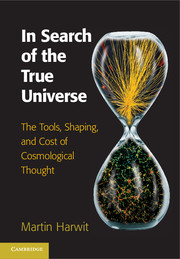Book contents
- Frontmatter
- Contents
- Preface
- Notes on Usage
- 1 The Nineteenth Century's Last Five Years
- Part I The Import of Theoretical Tools
- 2 An Overview
- 3 Conclusions Based on Principles
- 4 Conclusions Based on a Premise
- 5 Conclusions Based on Calculations
- 6 Ask the Right Questions, Accept Limited Answers
- Part II A National Plan Shaping the Universe We Perceive
- Part III The Cost of Discerning the True Universe
- Epilogue
- Appendix: Symbols, Glossary, Units and Their Ranges
- Index
- References
6 - Ask the Right Questions, Accept Limited Answers
Published online by Cambridge University Press: 05 December 2013
- Frontmatter
- Contents
- Preface
- Notes on Usage
- 1 The Nineteenth Century's Last Five Years
- Part I The Import of Theoretical Tools
- 2 An Overview
- 3 Conclusions Based on Principles
- 4 Conclusions Based on a Premise
- 5 Conclusions Based on Calculations
- 6 Ask the Right Questions, Accept Limited Answers
- Part II A National Plan Shaping the Universe We Perceive
- Part III The Cost of Discerning the True Universe
- Epilogue
- Appendix: Symbols, Glossary, Units and Their Ranges
- Index
- References
Summary
Asking the right question and being satisfied with the answer it yields is one of the most difficult tasks of astrophysical research. Concentrate on too small a problem and you may neglect essential extrinsic factors. Attempt to answer too broad a question and you may fail across the entire front.
As the 1920s were drawing to a close, two questions were being asked with increasing urgency: “What makes the stars shine?” and “What is the origin of the Chemical Elements?” To many, the two problems appeared related.
Gravitational contraction by then appeared an unlikely source of stellar energy. A potentially abundant supply of nuclear energy appeared to exist, to keep the stars shining for billions of years, but how it might be released was unknown. The known mass defects of heavy elements suggested that a merging of light elements to form heavier elements could both release sufficient energy and account for the existence of heavy elements. The emerging realization that hydrogen was the most abundant element in the Universe made this notion particularly attractive.
If we only understood the nature of nuclear reactions we might account for both the source of stellar energy and the relative abundances of the chemical elements. The prospects were heady!
- Type
- Chapter
- Information
- In Search of the True UniverseThe Tools, Shaping, and Cost of Cosmological Thought, pp. 97 - 118Publisher: Cambridge University PressPrint publication year: 2013



